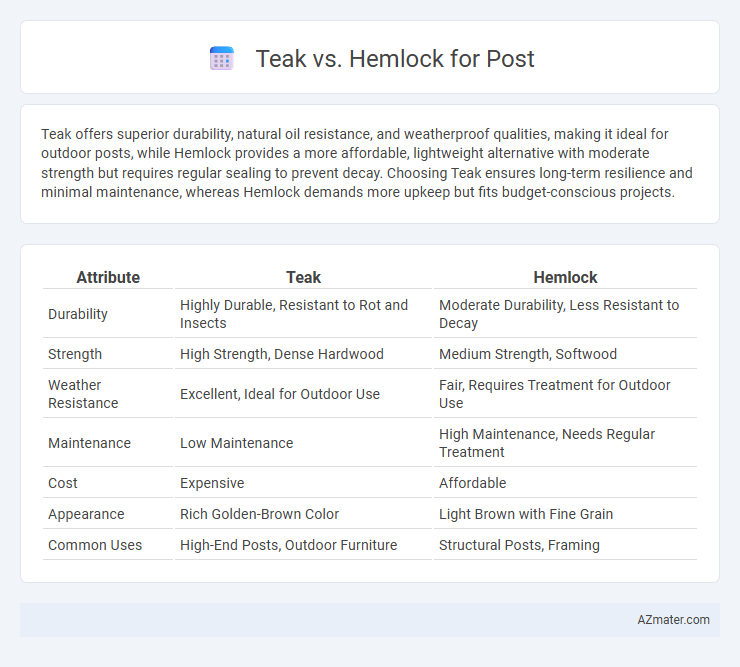Teak offers superior durability, natural oil resistance, and weatherproof qualities, making it ideal for outdoor posts, while Hemlock provides a more affordable, lightweight alternative with moderate strength but requires regular sealing to prevent decay. Choosing Teak ensures long-term resilience and minimal maintenance, whereas Hemlock demands more upkeep but fits budget-conscious projects.
Table of Comparison
| Attribute | Teak | Hemlock |
|---|---|---|
| Durability | Highly Durable, Resistant to Rot and Insects | Moderate Durability, Less Resistant to Decay |
| Strength | High Strength, Dense Hardwood | Medium Strength, Softwood |
| Weather Resistance | Excellent, Ideal for Outdoor Use | Fair, Requires Treatment for Outdoor Use |
| Maintenance | Low Maintenance | High Maintenance, Needs Regular Treatment |
| Cost | Expensive | Affordable |
| Appearance | Rich Golden-Brown Color | Light Brown with Fine Grain |
| Common Uses | High-End Posts, Outdoor Furniture | Structural Posts, Framing |
Introduction to Teak and Hemlock
Teak (Tectona grandis) is a dense, durable hardwood prized for its natural oils, resistance to decay, and vibrant golden-brown color, making it ideal for outdoor posts and structures exposed to harsh weather. Hemlock (Tsuga spp.) is a softwood characterized by its straight grain and moderate strength, commonly used in construction where budget considerations and ease of workability are important. Both woods offer unique advantages, but teak's superior durability and weather resistance generally make it a premium choice for long-lasting posts.
Origin and Availability
Teak is primarily sourced from Southeast Asia, particularly Myanmar, Thailand, and Indonesia, known for its dense grain and natural oils that enhance durability. Hemlock, native to the western regions of North America, especially the Pacific Northwest, is more widely available and often harvested from sustainable plantations. The availability of teak is comparatively limited and expensive due to controlled logging, while hemlock offers a more economical and accessible option for construction posts.
Strength and Durability
Teak wood offers exceptional strength and durability due to its high natural oil content, making it highly resistant to moisture, insects, and decay, which is ideal for outdoor posts. Hemlock, while strong and moderately durable, lacks the natural oils found in teak and is more prone to rot and insect damage unless properly treated. For long-lasting post applications exposed to harsh environmental conditions, teak outperforms hemlock in maintaining structural integrity over time.
Resistance to Decay and Insects
Teak wood offers superior resistance to decay and insect damage due to its natural oils and dense grain structure, making it highly durable for outdoor posts without the need for chemical treatment. Hemlock, while moderately resistant to decay, is more susceptible to insect attacks and requires preservative treatments to enhance its longevity in outdoor settings. Choosing teak over hemlock ensures longer-lasting posts with minimal maintenance in environments prone to moisture and pests.
Workability and Ease of Installation
Teak wood offers exceptional workability due to its natural oils, which make it easy to machine and resistant to warping or cracking during installation. Hemlock, while less oily, is lightweight and soft, allowing for easy cutting and nailing, but it may require more careful handling to prevent splitting. The combination of teak's durability and hemlock's manageability influences their installation methods, with teak requiring fewer treatments and hemlock benefiting from pre-drilling to improve fastening.
Aesthetic Differences
Teak wood exhibits a rich golden-brown hue with a natural oily texture that enhances its smooth, elegant appearance, making it highly sought after for decorative posts. Hemlock features a lighter, pale yellow to reddish-brown color with a straight grain pattern and a more rustic, natural finish, offering a contrasting aesthetic to the polished look of teak. The distinct visual qualities of teak and hemlock influence their selection for posts based on desired style, with teak providing a luxurious warmth and hemlock delivering a more understated, natural charm.
Maintenance Requirements
Teak offers superior durability and weather resistance, requiring minimal maintenance such as occasional cleaning and oiling to retain its natural oils and prevent drying. Hemlock, being less dense and more porous, demands more frequent sealing or staining to protect against moisture, rot, and insect damage. Regular inspections and touch-ups are essential for Hemlock posts to maintain structural integrity and appearance over time.
Cost Comparison
Teak posts command a higher price due to their natural durability, resistance to rot, and premium appearance, typically costing 2 to 3 times more per linear foot than Hemlock. Hemlock posts are more budget-friendly but require treatment to enhance longevity, making them a cost-effective choice for projects with tight financial constraints. When evaluating total expenses, factoring in maintenance and replacement intervals reveals that the initial lower cost of Hemlock may increase over time compared to the long-lasting investment of Teak.
Environmental Impact
Teak offers superior durability and natural resistance to decay, reducing the need for chemical treatments and minimizing environmental damage. Hemlock, while fast-growing and more sustainable in terms of harvest, often requires preservative treatments to withstand outdoor conditions, potentially impacting soil and water quality. Choosing teak supports long-term carbon sequestration due to its dense wood, whereas hemlock provides quicker regeneration but may necessitate more frequent replacement, influencing overall resource consumption.
Best Applications for Each Wood
Teak offers exceptional durability and natural resistance to water and insects, making it ideal for outdoor posts in marine environments, patios, and garden structures exposed to harsh weather. Hemlock is best suited for indoor applications or sheltered outdoor posts, where its moderate strength and affordability provide reliable support for furniture, framing, and temporary structures. Choosing teak for long-term, high-moisture exposure ensures longevity, while hemlock is preferred for budget-conscious projects with less environmental wear.

Infographic: Teak vs Hemlock for Post
 azmater.com
azmater.com